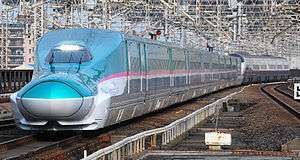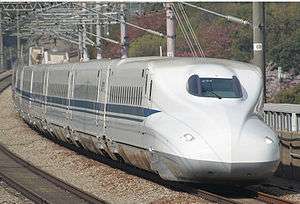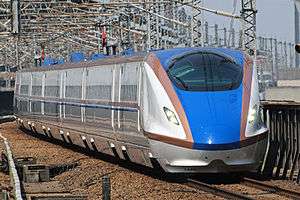E5 Series Shinkansen
The E5 series (E5系) is a Japanese Shinkansen high-speed train type operated by East Japan Railway Company (JR East) on Tōhoku Shinkansen services since 5 March 2011[4] and on Hokkaido Shinkansen services since 26 March 2016. A total of 59 10-car sets are on order, with three sets in service in time for the start of new Hayabusa services to Shin-Aomori in March 2011.[5]
| E5 series | |
|---|---|
E5 series shinkansen on a Hayabusa service, March 2011 | |
| Manufacturer | Hitachi, Kawasaki Heavy Industries |
| Replaced | 200 series, E1 series, E2 series, E4 series |
| Constructed | 2009– |
| Entered service | March 2011 |
| Number under construction | 160 vehicles (16 sets) |
| Number built | 430 vehicles (43 sets) |
| Number in service | 430 vehicles (43 sets) (as of 1 April 2019) |
| Formation | 10 cars per trainset |
| Fleet numbers | U1– |
| Capacity | 731 (658 Standard, 55 Green, 18 Gran Class)[1] |
| Operator(s) | JR East |
| Line(s) served | Tōhoku Shinkansen, Hokkaido Shinkansen |
| Specifications | |
| Car body construction | Aluminium alloy |
| Train length | 253 m (830 ft) |
| Car length | 26,500 mm (86 ft 11 in) (end cars) 25,000 mm (82 ft 0 in) (intermediate cars)[2] |
| Width | 3,350 mm (11 ft 0 in) |
| Height | 3,650 mm (12 ft 0 in) |
| Doors | E514: one per side plus one cab access door per side E515: one per side E523: two per side plus one cab access door per side Other intermediate cars: two per side |
| Maximum speed | 320 km/h (200 mph) |
| Weight | 453.5 t (446.3 long tons; 499.9 short tons) |
| Traction system | MT207 AC traction motors (300 kW)[3] |
| Power output | 9,600 kW (12,870 hp) |
| Acceleration | 1.71 km/(h⋅s) (0.48 m/s/s) |
| Electric system(s) | 25 kV AC, 50 Hz overhead catenary |
| Current collection method | Pantograph |
| Bogies | DT209 (motored), TR7008 (trailer) |
| Braking system(s) | Regenerative brake |
| Safety system(s) | DS-ATC |
| Multiple working | E3 series/E6 series |
| Track gauge | 1,435 mm (4 ft 8 1⁄2 in) standard gauge |
Design
Technology incorporated in these trains is derived from the experimental Fastech 360S train tested by JR East. The initial maximum speed in service was 300 km/h (186 mph), but this was raised to 320 km/h (199 mph) between Utsunomiya and Morioka from the start of the revised timetable on 16 March 2013.[6] The trains feature an electric active suspension.[7]
 PS208 pantograph
PS208 pantograph
Operations

As of 26 March 2016, E5 series trainsets work in a pool with similar JR Hokkaido H5 series trainsets,[8] and are used on the following services on the Tohoku and Hokkaido Shinkansen lines:[9]
- Hayabusa, since March 2011
- Hayate, since November 2011
- Yamabiko, since November 2011
- Nasuno, since March 2012
E5 series trainsets were first introduced on the new Hayabusa services between Tokyo and Shin-Aomori from 5 March 2011, initially operating at a maximum speed of 300 km/h. From 19 November 2011, a total of six E5 series trainsets were in operation, with sets also used on some Hayate and Yamabiko services. Hayate services operated coupled with E3 series Komachi services, and were limited to a maximum speed of 275 km/h.[10] From the start of the revised timetable on 17 March 2012, E5 series sets were also introduced used on some Nasuno all-stations services.[11]
Exterior
The exterior design of the trains is broadly based on the experimental Fastech 360S train, with a colour scheme of "Tokiwa" (常盤) green for the upper body and "Hiun" (飛雲) white for the lower body, separated by a "Hayate" pink stripe.[12]
 Bodyside "Hayabusa" logo
Bodyside "Hayabusa" logo- "Gran Class" logo on car 10, December 2010
Interior
Gran Class
Car 10 (at the Aomori end) is designated "Gran Class", featuring 18 power-reclining "shell" seats with leather seat covers arranged in 2+1 abreast configuration.[13] Originally given the provisional name "Super Green Car", seat pitch in the Gran Class car is 1,300 mm (51.2 in).[14] Seats are 520 mm (20.5 in) wide and recline to a maximum angle of 45 degrees.[13] The pre-series set, S11, did not initially include Gran Class accommodation.[1]
Green car
Car 9 is designated as "Green car" (first class) accommodation with 55 seats arranged in 2+2 abreast configuration. Seat pitch is 1,160 mm (45.7 in). Seats are 475 mm (18.7 in) wide and recline to an angle of 31 degrees.[13]
Ordinary class
Ordinary-class cars (cars 1 to 8) have a seat pitch of 1,040 mm (40.9 in), which is 60 mm (2.4 in) larger than on the E2 series trains.[2] Seating is arranged in 3+2 abreast configuration. AC power outlets are provided for window seats and rows of seats at car ends.[15]
 Interior of Gran Class car E514-21 in November 2014
Interior of Gran Class car E514-21 in November 2014- Interior of a Green car in March 2016
- Interior of an ordinary-class car (car 3) in December 2015
 An AC power outlet in an ordinary-class car
An AC power outlet in an ordinary-class car
Formation
The production sets are formed as follows, with car 1 at the Tokyo end and car 10 at the Aomori end.[16]
| Car No. | 1 | 2 | 3 | 4 | 5 | 6 | 7 | 8 | 9 | 10 |
|---|---|---|---|---|---|---|---|---|---|---|
| Designation | T1c | M2 | M1 | M2 | M1k | M2 | M1 | M2 | M1s | Tsc |
| Numbering | E523 | E526-100 | E525 | E526-200 | E525-400 | E526-300 | E525-100 | E526-400 | E515 | E514 |
| Weight (t) | 41.9 | 45.9 | 46.0 | 46.3 | 46.1 | 46.8 | 46.8 | 46.0 | 45.8 | 42.7 |
| Capacity | 29 | 100 | 85 | 100 | 59 | 100 | 85 | 100 | 55 | 18 |
| Facilities | Toilet | Toilet, cardphone | Toilet, AED, cardphone, wheelchair space | Toilet | Toilet, wheelchair space, conductor's compartment |
Cars 3 and 7 each have one single-arm pantograph, although only one is normally raised in service.[17]
History
The pre-series set, S11, was delivered to Sendai Depot in May 2009 ahead of extensive test running on the Tohoku Shinkansen.[18] Cars 1 to 5 were built by Hitachi in Yamaguchi Prefecture, and cars 6 to 10 were built by Kawasaki Heavy Industries in Hyogo Prefecture.[19] Set S11 made its first appearance at Tokyo Station on 9 December 2009.[20]
The first full-production set, U2, was delivered to Sendai Depot in December 2010.[17]
In May 2012, the E5 series was awarded the 2012 Blue Ribbon Award, presented annually by the Japan Railfan Club.[21] A formal presentation ceremony was held at Tokyo Station on 20 November 2012.[22]
The pre-series set, S11, was upgraded to full-production standard in February 2013 and renumbered U1.[23] It retains the flush plug doors for the passenger doors immediately behind the driving cabs, whereas the full-production sets have recessed sliding doors.[23]
From the start of the revised timetable on 16 March 2013, the maximum speed in service was raised from 300 km/h (186 mph) to 320 km/h (199 mph) between Utsunomiya and Morioka.[6]
Fleet list
As of 1 April 2019, the fleet is as follows.[24]
| Set number | Manufacturer | Date delivered | Remarks |
|---|---|---|---|
| U1 | Hitachi/Kawasaki HI | 15 June 2009 | Pre-series set, originally numbered S11, modified February 2013 |
| U2 | Kawasaki HI | 13 December 2010 | Full-production sets |
| U3 | Hitachi | 31 January 2011 | |
| U4 | Hitachi | 18 February 2011 | |
| U5 | Hitachi | 19 August 2011 | |
| U6 | Kawasaki HI | 27 September 2011 | |
| U7 | Hitachi | 13 October 2011 | |
| U8 | Kawasaki HI | 14 November 2011 | |
| U9 | Kawasaki HI | 5 December 2011 | |
| U10 | Hitachi | 30 January 2012 | |
| U11 | Kawasaki HI | 17 February 2012 | |
| U12 | Kawasaki HI | 2 April 2012 | |
| U13 | Hitachi | 26 April 2012 | |
| U14 | Kawasaki HI | 31 May 2012 | |
| U15 | Hitachi | 11 June 2012 | |
| U16 | Hitachi | 26 July 2012 | |
| U17 | Kawasaki HI | 24 August 2012 | |
| U18 | Kawasaki HI | 14 September 2012 | |
| U19 | Kawasaki HI | 12 October 2012 | |
| U20 | Hitachi | 22 November 2012 | |
| U21 | Kawasaki HI | 25 December 2012 | |
| U22 | Hitachi | 31 January 2013 | |
| U23 | Kawasaki HI | 22 February 2013 | |
| U24 | Hitachi | 28 March 2013 | |
| U25 | Kawasaki HI | 10 April 2013 | |
| U26 | Hitachi | 30 May 2013 | |
| U27 | Kawasaki HI | 7 June 2013 | |
| U28 | Hitachi | 26 July 2013 | |
| U29 | Kawasaki HI | 7 December 2015 | |
| U30 | Hitachi | 15 January 2016 | |
| U31 | Kawasaki HI | 1 February 2016 | |
| U32 | Hitachi | 3 February 2017 | |
| U33 | Kawasaki HI | 16 January 2017 | |
| U34 | Hitachi | 13 October 2017[25] | |
| U35 | Kawasaki HI | 19 July 2017 | |
| U36 | Kawasaki HI | 25 August 2017 | |
| U37 | Kawasaki HI | 21 September 2017 | |
| U38 | Kawasaki HI | 9 February 2018 | |
| U39 | Hitachi | 24 August 2018 | |
| U40 | Hitachi | 11 January 2019 | |
| U41 | Kawasaki HI | 23 March 2018 | |
| U42 | Hitachi | 4 February 2019 | |
| U43 | Kawasaki HI | 4 March 2019 | |
| U44 | |||
| U45 | |||
| U46 | |||
| U47 | |||
| U48 | |||
| U49 | |||
| U50 | |||
| U51 | |||
| U52 | |||
| U53 | |||
| U54 | |||
| U55 | |||
| U56 | |||
| U57 | |||
| U58 | |||
| U59 |
Special train services
A special Joetsu Shinkansen 30th Anniversary (上越新幹線開業30周年号」, Jōetsu Shinkansen Kaigyō 30-shūnen-gō) service ran from Niigata to Tokyo on 17 November 2012 using E5 series set U8, with a special ceremony at Niigata Station before departure.[26][27] This was the first revenue-earning service operated on the Joetsu Shinkansen by an E5 series trainset.[27]
Derivatives
An order for four 10-car trainsets based on the E5 series design was placed by JR Hokkaido in February 2014 for use on Hokkaido Shinkansen services from March 2016.[28] Classified H5 series, these trains incorporate minor interior design differences compared with the E5 series.[29]
Future developments
The E5 series trains have been chosen for use on the planned $16.8 Billion Mumbai–Ahmedabad high-speed rail corridor in India, scheduled to open on 15 August 2022.[30]
See also
- List of high speed trains
References
- MLIT press release: 東北新幹線に導入予定の新型高速新幹線車両(E5系)に係る安全性確認書の交付を行います (9 June 2009). Retrieved on 18 June 2009. (in Japanese)
- JR東日本 E5系新幹線電車(量産先行車) [JR East E5 series shinkansen pre-series train]. Tetsudō Daiya Jōhō. Japan: Kotsu Shimbun. 38 (304): 68–69. August 2009.
- 鉄道のテクノロジー 3 JR高速特急Part.1 [Railway Technology 3: JR High-speed Limited Express Trains Part.1] (in Japanese). Sanei Shobo Publishing. July 2009. p. 9. ISBN 978-4-7796-0669-4.
- 新しい東北新幹線の列車愛称等の決定について [Name selected for new Tohoku Shinkansen services] (PDF) (in Japanese). JR East. 11 May 2010. Retrieved 11 May 2010.
- 新型新幹線は白とピンク スピード感表現 [New Shinkansen trains will be white and pink, expressing sense of speed] (in Japanese). Sankei News. 3 February 2009. Archived from the original on 18 February 2013. Retrieved 3 February 2009.
- JR電車編成表 2016冬 [JR EMU Formations - Winter 2016] (in Japanese). Japan: Kotsu Shimbunsha. 18 November 2015. p. 12. ISBN 978-4-330-62315-3.
- "NSSMC's Active Suspensions for Railway Cars Are Adopted for Kyushu Railway Company's Cruise Train "Seven Stars in Kyushu"". nipponsteel.com. Nippon Steel & Sumitomo Metal Corporation. 11 October 2013. Retrieved 1 August 2019.
- Ltd, DVV Media International. "Hokkaido Shinkansen inaugurated".
- JR時刻表 [JR Timetable] (in Japanese). Japan: Kotsu Shimbunsha. 2016. pp. 977–979. EAN 4910053110464.
- 東北新幹線「はやぶさ」に投入しているE5系車両を「はやて」「やまびこ」に導入! [Tohoku Shinkansen "Hayabusa" E5 series trains to be introduced on "Hayate" and "Yamabiko" services] (PDF). Press release (in Japanese). Japan: East Japan Railway Company. 12 September 2011. Retrieved 12 September 2011.
- 2012年3月ダイヤ改正について [March 2012 Timetable Revision] (PDF) (in Japanese). Japan: East Japan Railway Company. 16 December 2011. Retrieved 16 December 2011.
- 新型高速新幹線車両(E5系)のデザインについて [Information on Design of New Shinkansen E5 Series Trains] (PDF) (in Japanese). JR East. 3 February 2009. Retrieved 3 February 2009.
- 新型高速新幹線車両(E5 系)「スーパーグリーン車(仮称)」の正式名称・インテリアデザイン決定について [Official name and interior design selected for new Tōhoku Shinkansen "Super Green Car"] (PDF) (in Japanese). JR East. 11 May 2010. Retrieved 11 May 2010.
- "First Introduction of a 1st Class "Super Green Car" (tentative name) for New "Hayate" Shinkansen Trains (E5 Series)!" (PDF). JR East. 8 April 2008. Archived from the original (PDF) on 24 January 2009. Retrieved 3 February 2009.
- Osaka, Naoki (10 April 2014). なぜ北陸新幹線は全席コンセント付きなのか [Why does the Hokuriku Shinkansen have power outlets for every seat?]. Toyo Keizai Online (in Japanese). Japan: Toyo Keizai Inc. p. 3. Retrieved 23 June 2014.
- JR東日本 E5系新幹線電車(量産車) [JR East E5 series Shinkansen (full-production version)]. Tetsudō Daiya Jōhō Magazine. Vol. 40 no. 322. Japan: Kotsu Shimbun. February 2011. pp. 80–83.
- JR電車編成表 2012冬 [JR EMU Formations - Winter 2012]. Japan: JRR. October 2011. p. 10. ISBN 978-4-330-25611-5.
- E5系S11編成仙台港に陸揚げ [E5 series set S11 unloaded at Sendai Port]. Japan Railfan Magazine Online (in Japanese). Koyusha Co., Ltd. 24 May 2009. Retrieved 25 May 2009.
- JR車両の動き [JR Rolling Stock Changes]. Tetsudō Daiya Jōhō. Japan: Kōtsū Shimbun. 38 (305): 125. September 2009.
- E5系が東京へ初入線 [E5 series reaches Tokyo for first time]. Japan Railfan Magazine Online (in Japanese). Koyusha Co., Ltd. 10 December 2009. Retrieved 11 December 2009.
- ブルーリボン賞・ローレル賞 選定車両一覧 [Blue Ribbon Award & Laurel Prize Winner List] (in Japanese). Japan: Japan Railfan Club. 29 May 2012. Archived from the original on 26 October 2010. Retrieved 29 May 2012.
- ブルーリボン賞・ローレル賞受賞式 [Blue Ribbon and Laurel Prize Presentation Ceremonies]. Japan Railfan Magazine. Vol. 53 no. 622. Japan: Koyusha Co., Ltd. February 2013. p. 64.
- E5系S11編成が量産化改造を実施 [E5 series set S11 modified to full-production standard]. RM News (in Japanese). Japan: Neko Publishing. 28 February 2013. Retrieved 28 February 2013.
- JR電車編成表 2018冬 [JR EMU Formations - Winter 2018] (in Japanese). Japan: Kotsu Shimbunsha. 15 November 2017. p. 12. ISBN 978-4-330-84117-5.
- JR車両のうごき [JR rolling stock changes]. Tetsudo Daiya Joho Magazine (in Japanese). Vol. 47 no. 407. Japan: Kotsu Shimbun. March 2018. p. 102.
- おかげさまで上越新幹線開業30周年 [Joetsu Shinkansen 30th Anniversary Celebrations] (PDF) (in Japanese). Japan: East Japan Railway Company, Niigata Division. 12 September 2012. Archived from the original (PDF) on 20 September 2012. Retrieved 15 September 2012.
- 団体臨時列車「上越新幹線開業30周年記念号」,E5系で運転 [Special "Joetsu Shinkansen 30th Anniversary" runs using E5 series]. Japan Railfan Magazine Online (in Japanese). Japan: Koyusha Co., Ltd. 18 November 2012. Retrieved 18 November 2012.
- 北海道新幹線4編成40両、年内に納入開始 JR社長会見、総額180億円 [4 Hokkaido Shinkansen sets to be delivered this year at cost of 18 billion yen]. Doshin Web (in Japanese). Japan: The Hokkaido Shimbun Press. 13 March 2014. Archived from the original on 12 March 2014. Retrieved 13 March 2014.
- 北海道新幹線「H5系」、内装には雪の結晶も [Hokkaido Shinkansen "H5 series" - Interiors to feature snowflake design]. Yomiuri Online (in Japanese). Japan: The Yomiuri Shimbun. 16 April 2014. Archived from the original on 15 April 2014. Retrieved 16 April 2014.
- Sharma, Kiran (14 September 2017). "PM Modi and Japan's Abe launch Indian shinkansen project". Nikkei Asian Review. Nikkei Inc. Retrieved 31 July 2018.
Further reading
- Tajima, Shinichiro. "Development of Series E5 Shinkansen Rolling Stock" (PDF). JR East Technical Review No. 16. Japan: East Japan Railway Company. pp. 11–12. Retrieved 26 April 2011.
External links
| Wikimedia Commons has media related to E5 series. |
- JR East E5 series (in Japanese)
- JR East E5 series Hayabusa/Hayate/Yamabiko/Nasuno information (in Japanese)

